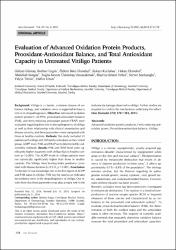Evaluation of Advanced Oxidation Protein Products, Prooxidant-Antioxidant Balance, and Total Antioxidant Capacity in Untreated Vitiligo Patients

View/
Access
info:eu-repo/semantics/openAccessDate
2015Author
Güntaş, GülcanEngin, Burhan
Ekmekci, Özlem Balcı
Kutlubay, Zekayi
Ekmekci, Hakan
Songur, Abdullah
Uzun, Hafize
Metadata
Show full item recordAbstract
Vitiligo is a chronic, common disease of unknown etiology, and oxidative stress is suggested to have a role in its etiopathogenesis. Objective: Advanced oxidation protein products (AOPPs), prooxidant-antioxidant balance (PAB), and ferric-reducing antioxidant power (FRAP) were evaluated regarding their role in the pathogenesis of vitiligo as well as their relationship with clinical presentation and disease severity, and these parameters were compared with those of healthy controls. Methods: The study included 53 patients with vitiligo and 20 healthy volunteers as the control group. AOPP level, PAB, and FRAP were determined by colorimetric methods. Results: PAB and FRAP level were significantly higher in patients with vitiligo than in healthy controls (p < 0.001). The AOPP levels in vitiligo patients were not statistically significantly higher than those in healthy controls. The Vitiligo Area Scoring Index positively correlated with disease duration (r(s): 0.531, p <0.001). Conclusion: To the best of our knowledge, this is the first report of AOPP and PAB status in vitiligo. PAB may be used as an indicator for Oxidative stress in the etiopathogenesis of vitiligo. Our results show that these parameters may play a major role in the melanocyte damage observed in vitiligo. Further studies are required to confirm the mechanisms underlying this effect.


















